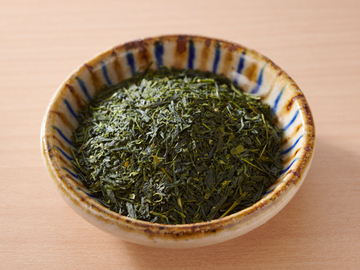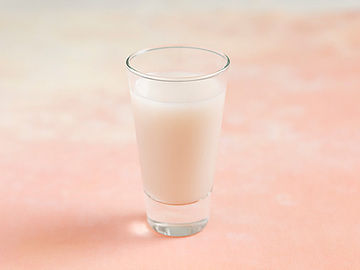Beverages

On this page, two types of traditional Japanese beverages are picked up and introduced; tea (green tea) and amazake.
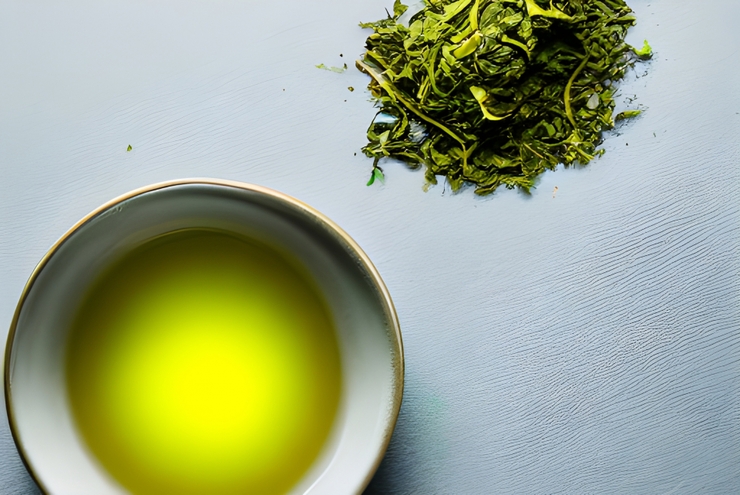
It is said that tea was brought to Japan early in the Nara era. In the Kamakura era, tea cultivation began in various places in Japan due to the efforts of the Zen Buddhist monks. With a spread of the Zen Buddhism, the custom of tea drinking widely spread. Sencha flourished in the Edo era, and the export of tea began at the end of the Edo era.
However, it is said that the tea first brought from China was compressed tea called heicha. To produce heicha, tea leaves are steamed and compressed into a solid form. The pressed blocks of tea are then dried and roasted. When drinking, a block of tea is scraped off and crushed, and put in boiling water. Salt was added in some cases according to the research.
Then, Zen master Eisai, the founder of the Rinzai school, introduced the matcha method of dissolving tea powder in hot water. Eisai also wrote "Kissa Yojoki" describing the benefits of tea and tea making methods, and offered the book to the third shogun of the Kamakura shogunate, Minamoto no Sanetomo. Sen no Rikyu completed the style of tea ceremony during the Sengoku era.
Globally, tea is classified into green tea (unfermented), oolong tea (semi-fermented) and black tea (fermented) according to the fermentation level of tea leaves. As for green tea, China is the top producing country, followed by Japan.
In Japan, the top tea producing prefecture is Shizuoka (25,200 tons), followed by Kagoshima (23,900 tons), Mie and Miyazaki. ("Tea-picked Area, Yield of Raw Leaf and Production of Crude Tea of Green Tea Produced in 2020" by the Ministry of Agriculture, Forestry and Fisheries)
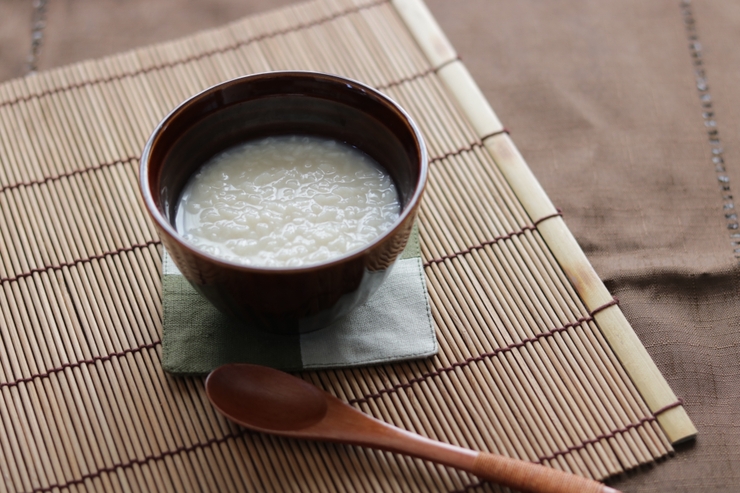
Amazake is a very sweet, nutritious fermented drink. "Zake" in amazake means alcohol, but amazake contains no (or very little) alcohol and does not fall under the category of alcoholic beverages. The ingredients are pretty simple—rice and koji or sake lees (sakekasu). Amazake is one of the traditional beverages indigenous to Japan, which utilizes rice, the Japanese staple food, and koji, an essential ingredient for Washoku, the traditional Japanese cuisine.
There are several theories about the origin of amazake. "Nihonshoki (Chronicles of Japan)" written in the Nara era contains a description of amanotamuzake, which is considered to be very sweet sake made of rice koji containing a very low alcohol concentration and closer to amazake rather than today's sake. Amazake was a valuable sweet drink until the use of sugar became common in the Edo era. Amazake became popular among the common people in the Edo era. Though many people today think amazake is a beverage that is drunk in the winter or new year, amazake was especially popular in the summer in the Edo era. It is said that many amazake peddlers were seen on the streets. This is because people at that time tried to survive the hot summers by drinking amazake due to its high nutritious value, so it was called a "drinkable intravenous drip."
Characteristics and Types
Beverages are classified into two types: tea (green tea) and amazake and the outline is introduced.
In Japan, there is a wide variety of tea with different making methods in each area. People enjoy different aroma, tastes and colors. The types of green tea include kabusecha, tama-ryokucha and bancha as well as sencha, gyokuro and matcha.
Sencha is a representative tea in Japan. According to the research, the way of making sencha was established in the early 18th century. Even today people recall sencha when they hear "tea."
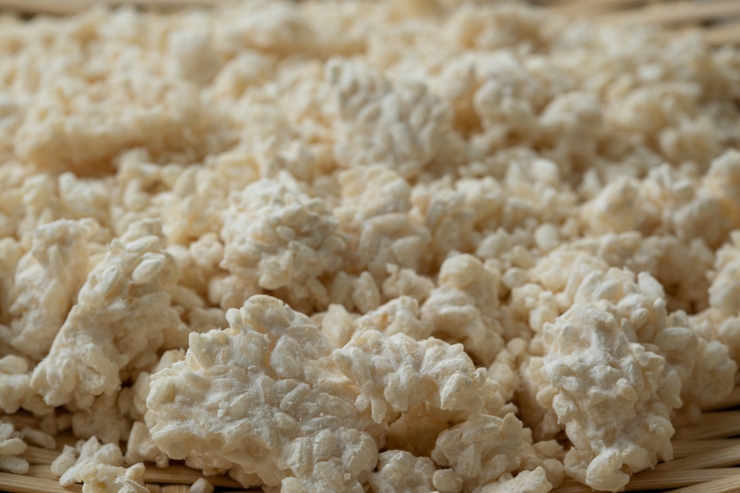
[Amazake]
Amazake is made in two ways: one is to use rice koji and the other is sake lees. They called differently to make the difference clear. Amazake made of rice koji is called "koji amazake" and amazake made of sake lees "sakekasu amazake," respectively. Koji amazake is a fermented sweet beverage. Its characteristic sweetness comes from Aspergillus oryzae-derived enzymes acting on starch, the main component of rice. Sakekasu amazake is made by dissolving sake lees in hot water and adding sugar. Sake lees, which is a byproduct from the sake production process, is an ingredient rich in amino acid and vitamins. The production of sakekasu amazake does not involve a fermentation process, but sakekasu amazake can also be said to be a fermented drink as sake lees is a by-product of brewing refined sake.
Production Methods
Several production methods of tea (green tea) and amazake introduced in the previous section are excerpted and described.
[Tea (Green tea)]
In the spring, fresh leaves are picked and quickly steamed in tea baskets. After letting it cool, they are heated to dry. Then, tea leaves are fanned, rolled, spread and kneaded before they are shaped. For the shiage refining process, tea leaves are rolled and dried again to become sencha.
The production process of gyokuro is almost the same as with sencha, except that young tea leaves are grown in tea fields under a sun-shielding covering. The tea brewed and extracted at a low temperature is called gyokuro.
Matcha, as the name indicates, is the tea that is ground into powder and dissolved in hot water. Though the production process is simple—steaming and drying tea leaves—matcha has different tastes and flavors depending on how the tea leaves are steamed or dried in addition to the quality of tea leaves.
[Amazake]
Koji amazake is made by adding water and koji to cooked rice and fully stirring. Then the mixture is covered with a lid and left overnight at the temperature of 55 to 60°C. Stirring during this process promotes fermentation.
Sakekasu amazake is made of sake lees, water and sugar only. Sake lees are put in boiling water and well stirred after turning down the heat. Once sake lees dissolve, turn up the heat and add sugar. Though sake lees contain a slight amount of alcohol, heating allows alcohol to evaporate.
Relationship with Regions
Some of tea (green tea) and amazake that are related to each region or have characteristic production methods or history are described.
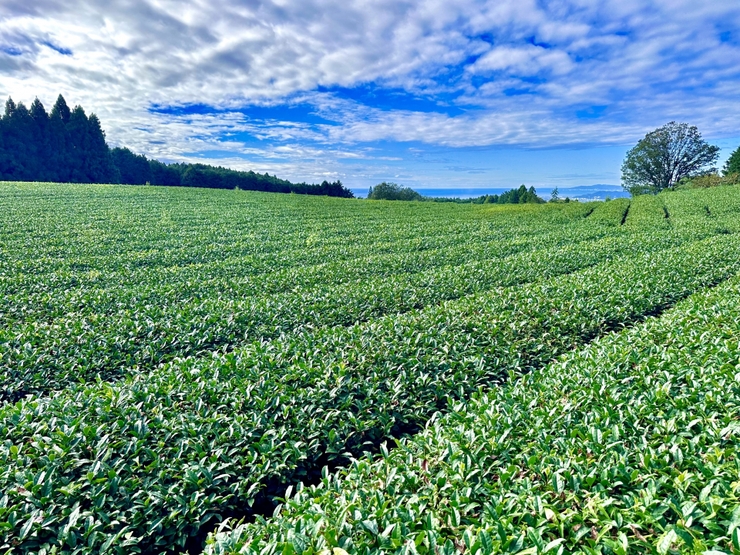
[Tea (Green tea)]
There are numerous tea production regions and brands, such as Sayama-cha in Saitama Prefecture, Shizuoka-cha in Shizuoka Prefecture, Nishio-cha in Aichi Prefecture, Uji-cha in Kyoto Prefecture, Awa-bancha in Tokushima Prefecture, Yame-cha in Fukuoka Prefecture, Ureshino-cha in Saga Prefecture and Kagoshima-cha in Kagoshima Prefecture, to name a few.
Tea is one of Japan's traditional beverages. Tea production takes time and effort, and tea has different tastes and flavors depending on the characteristics of tea leaves and the temperature and quality of the water used. Tastes change depending on how to brew it. Meanwhile, various tea in plastic bottles are sold today. The tea culture is expected to be enjoyed in various styles in different opportunities and locations of tea drinking.
[Amazake]
Amazake has regional characteristics according to the different nature of koji amazake and sakekasu amazake. Koji amazake tends to be drunk in the regions where the koji fermentation culture such as miso and soy sauce is deeply rooted. On the other hand, sakekasu amazake is more likely to be produced in the regions where there are many sake breweries because sake lees are a byproduct from the sake production process. Different sake breweries have sake lees with different tastes and flavors, which are the characteristics of each amazake and embody the regional characteristics.
Contribution to Sustaibability and SDGs
After drinking green tea, used tea leaves become waste. Nowadays, used tea leaves are effectively utilized as fertilizer or feed. The research for recycling used tea leaves into construction, resin, paper or other resources is now underway. (12. Responsible Consumption and Production)
Reference
Masaharu Horii, Yoichiro Nakamura, and Miyuki Kato, edited by the Japanese Society of Traditional Food, "Nihon no Dento Shokuhin Jiten" [Encyclopedia of Traditional Japanese Food], Asakura Publishing Co., Ltd., p.153-186

